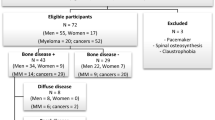Abstract
Objective
To evaluate the effect of half-dose intravenous gadolinium contrast on the enhancement of bone and soft tissue tumors.
Materials and methods
This study is HIPAA compliant and informed consent was waived by the institutional review board. An institutional database search was performed over a 1-year period for patients with full- and half-dose MR examinations performed for musculoskeletal oncologic indications. Examination pairs that were identical with regard to field strength and presence or absence of fat saturation were included, resulting in 29 paired examinations. When multiple, the lesion that was best delineated and enhanced well on the first examination in the pair was chosen, yielding 17 bone and 12 soft tissue. Five musculoskeletal radiologists blinded to dosages were asked to assess for a difference in enhancement when comparing the lesion on both examinations and to rate the degree of difference on a three-point scale. They were also asked to identify the examination on which the lesion enhanced less (tallied as low dose). Results were analyzed with the exact binomial test.
Results
The readers perceived an enhancement difference in 41% (59/145) of studies (p = 0.03) and the majority were rated as “mild” (66%, 39/59). The readers did not accurately identify the low-dose examinations (54% correctly identified, 32/59, p = 0.60).
Conclusions
Half-dose gadolinium enhancement of lesions could not be accurately distinguished from full-dose enhancement upon review of the same lesion imaged at both concentrations.


Similar content being viewed by others
References
Grobner T. Gadolinium–a specific trigger for the development of nephrogenic fibrosing dermopathy and nephrogenic systemic fibrosis? Nephrol Dial Transplant. 2006;21:1104–8.
Marckmann P, Skov L, Rossen K, et al. Nephrogenic systemic fibrosis: suspected causative role of gadodiamide used for contrast-enhanced magnetic resonance imaging. J Am Soc Nephrol. 2006;17:2359–62.
Lee CU, Wood CM, Hesley GK, et al. Large sample of nephrogenic systemic fibrosis cases from a single institution. Arch Dermatol. 2009;145:1095–102.
Abujudeh HH, Kaewlai R, Kagan A, et al. Nephrogenic systemic fibrosis after gadopentetate dimeglumine exposure: case series of 36 patients. Radiology. 2009;253:81–9.
Jimenez SA, Artlett CM, Sandorfi N, et al. Dialysis-associated systemic fibrosis (nephrogenic fibrosing dermopathy): study of inflammatory cells and transforming growth factor beta1 expression in affected skin. Arthritis Rheum. 2004;50:2660–6.
Ting WW, Stone MS, Madison KC, Kurtz K. Nephrogenic fibrosing dermopathy with systemic involvement. Arch Dermatol. 2003;139:903–6.
United, States, Food, and, Drug, Administration. Information for Healthcare Professionals Gadolinium-Based Contrast Agents for Magnetic Resonance Imaging (marketed as Magnevist, MultiHance, Omniscan, OptiMARK, ProHance). http://www.fda.gov/Drugs/DrugSafety/PostmarketDrugSafetyInformationforPatientsandProviders/ucm142884.htm. Published June 2006, updated December 2006 and May 2007, accessed November 2009. In.
Kanal E, Barkovich AJ, Bell C, et al. ACR guidance document for safe MR practices: 2007. AJR Am J Roentgenol. 2007;188:1447–74.
Rinck PA, Muller RN. Field strength and dose dependence of contrast enhancement by gadolinium-based MR contrast agents. Eur Radiol. 1999;9:998–1004.
Haustein J, Laniado M, Niendorf HP, et al. Administration of gadopentetate dimeglumine in MR imaging of intracranial tumors: dosage and field strength. AJNR Am J Neuroradiol. 1992;13:1199–206.
Erlemann R, Reiser MF, Peters PE, et al. Musculoskeletal neoplasms: static and dynamic Gd-DTPA–enhanced MR imaging. Radiology. 1989;171:767–73.
Harkens KL, Moore TE, Yuh WT, et al. Gadolinium-enhanced MRI of soft tissue masses. Australas Radiol. 1993;37:30–4.
Verstraete KL, Vanzieleghem B, De Deene Y, et al. Static, dynamic and first-pass MR imaging of musculoskeletal lesions using gadodiamide injection. Acta Radiol. 1995;36:27–36.
Fletcher BD, Hanna SL, Fairclough DL, Gronemeyer SA. Pediatric musculoskeletal tumors: use of dynamic, contrast-enhanced MR imaging to monitor response to chemotherapy. Radiology. 1992;184:243–8.
Erlemann R, Sciuk J, Bosse A, et al. Response of osteosarcoma and Ewing sarcoma to preoperative chemotherapy: assessment with dynamic and static MR imaging and skeletal scintigraphy. Radiology. 1990;175:791–6.
Barile A, Caulo M, Zugaro L, Di Cesare E, Gallucci M. Masciocchi C [Staging and re-staging of soft tissue sarcoma using MRI. Usefulness of contrast media]. Radiol Med. 2001;101:444–55.
Vanel D, Shapeero LG, De Baere T, et al. MR imaging in the follow-up of malignant and aggressive soft-tissue tumors: results of 511 examinations. Radiology. 1994;190:263–8.
Beltran J, Chandnani V, McGhee Jr RA, Kursunoglu-Brahme S. Gadopentetate dimeglumine-enhanced MR imaging of the musculoskeletal system. AJR Am J Roentgenol. 1991;156:457–66.
Prince MR, Zhang H, Morris M, et al. Incidence of nephrogenic systemic fibrosis at two large medical centers. Radiology. 2008;248:807–16.
Lauenstein TC, Salman K, Morreira R, et al. Nephrogenic systemic fibrosis: center case review. J Magn Reson Imaging. 2007;26:1198–203.
Martin DR, Krishnamoorthy SK, Kalb B, et al. Decreased incidence of NSF in patients on dialysis after changing gadolinium contrast-enhanced MRI protocols. J Magn Reson Imaging. 2010;31:440–6.
Author information
Authors and Affiliations
Corresponding author
Additional information
This work was presented in abstract form at the RSNA on 11/30/2009 (Paper number SSC11-01).
Rights and permissions
About this article
Cite this article
Costelloe, C.M., Murphy, W.A., Haygood, T.M. et al. Comparison of half-dose and full-dose gadolinium MR contrast on the enhancement of bone and soft tissue tumors. Skeletal Radiol 40, 327–333 (2011). https://doi.org/10.1007/s00256-010-1028-8
Received:
Revised:
Accepted:
Published:
Issue Date:
DOI: https://doi.org/10.1007/s00256-010-1028-8




